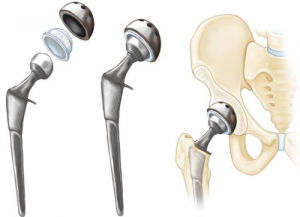The are over 200,000 hip replacements a year with the majority being performed on people between the ages of 50-80. Hip replacements are recommended to relieve pain and decreased mobility in the hip often due to arthritis and other degenerative processes .
Total Hip Replacement
A total hip replacement involves replacing the femur head ( proximal end of the thigh bone) with a metal facsimile as well as replacing the part of the pelvis the makes up the hip socket known as the acetabulum. The surgery is either performed with incisions in the front ( anterior approach ) or the back ( posterior approach) of the hip. With a posterior approach it is necessary to cut through the muscle to access the hip joint which usually requires a longer recovery time. Because of this some surgeons recommend an anterior approach . When done this way there may be less trauma to the surrounding muscle tissue which is moved aside instead of cut and patients can therefore get back to their daily activities sooner. After either surgery patients will embark on an intensive course of physical therapy with the goal of getting them up on their feet and walking unassisted as soon as possible.

One often overlooked issue in rehab is that any muscular imbalances that the client had before the surgery will most likely still exist. This could include muscular compensations that the person developed in response to their painful hip or could even be the dysfunctional patterning that created the wear and tear in the first place. The significance of this is that if the patient’s pain was partially due to muscular imbalance ( not just the pain from bone on bone contact in the joint) they may continue to feel hip pain long after the surgery has healed and may continue to until this imbalance is remedied . That is where an experienced Pilates instructor can be of great help.
How Pilates can help
A knowledgeable instructor will first assess the strength and flexibility of the joint. Then look for recruitment dysfunctions, identifying muscles that are dominating the movement at the hip and muscles that are under active as well. The retraining will begin with isometric holds which safely support the joint in a variety of positions and the core musculature that stabilizes the pelvis and lumber spine ( lower back) will need to be optimized . Then based on the initial assessment the instructor will create a strengthening program that takes the hip safely through all ranges of motion , while focusing on the clients individual needs. Special attention will be paid to exercises that protect the the joints of the body as a whole. And balance training will be incorporated to minimize falling and the possibility of future injury.
Pilates serves as an important and valuable adjunct to Physical Therapy and helps people return to life!
Mongoose Bodyworks is a boutique Pilates studio in Soho NYC that focuses on delivering customized private sessions designed for your exact needs.
Halle Clarke NCPT is a 2nd generation master teacher having studied closely with two of the great NYC protégés of Joseph Pilates: Kathy Grant and Romana Krysanowska. Halle opened Mongoose Bodyworks, a boutique Pilates Studio that offers personalized Pilates sessions in New York City in 1999.
As well as training in Pilates Halle has pursued studies in ideokensiology, anatomy, biomechanics, muscle energy technique, trigger point therapy, neuromuscular re-patterning, Alexander technique, The Feldenkrais Method, Polarity therapy and Cranio-Sacral Therapy. She has additional certifications from the PMA-CPT and ACE. Halle integrates all of her extensive studies of the body into her work as a New-York based Pilates Instructor and Teacher Trainer.
She has been conducting Pilates Teacher Trainings for Balanced Body since 2006 both in New York and around the country. Halle has taught Master Pilates classes nationally and internationally, including at The PMA Conference and Mind Body Expo.


